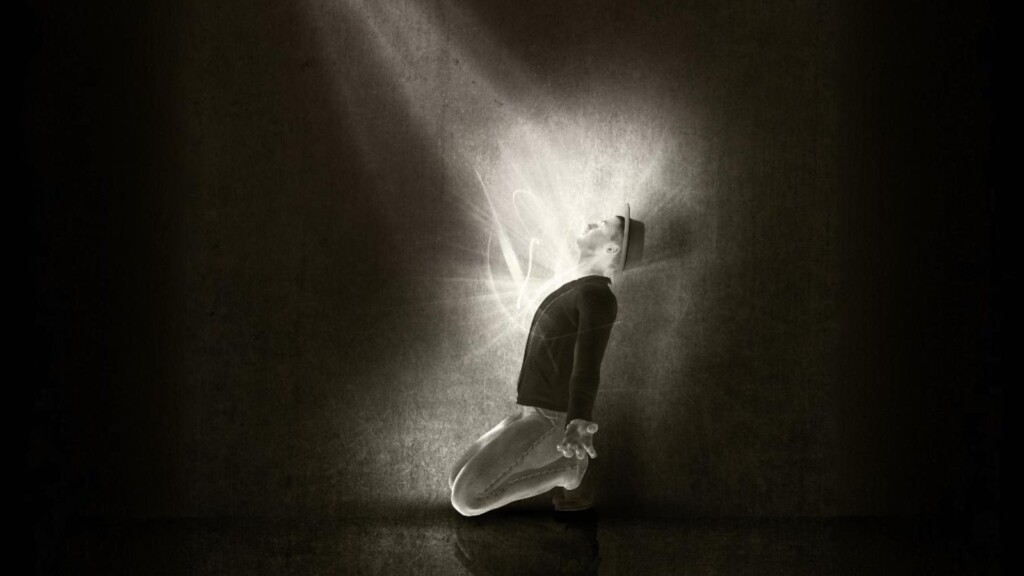Steadfastness in Devotion
(Based on the live discourse of Param Dwij)
(परम द्विज के प्रवचन पर आधारित)

Dear Dwij,
Have you ever paused in the midst of life’s relentless chaos to truly immerse yourself in the subtle yet powerful draw of a greater purpose? I invite you to take a moment to sit with me and embark on a journey into the sacred art of devotion together. Devotion, often referred to as bhakti, is not just a spiritual path; it is a profoundly transformative experience that can inspire and motivate us to unlock our fullest potential. The journey involves the full spectrum of human emotion, inviting us to cultivate a deep sense of love, unwavering trust, and heartfelt surrender to the higher power that guides our existence. This profound commitment challenges us to open our hearts, trust in a force greater than ourselves, and recognise all things’ interconnectedness.
As we navigate this journey, we begin to see devotion as a practice that inspires and motivates us to unlock our fullest potential. It engages us in the sacred dance of life, where every act becomes an expression of worship—whether through kindness, selfless service, or simply gratitude for each moment. Embracing devotion allows us to transcend our limited selves, urging us to become the best versions of who we can be, fuelled by the light of a deeper connection to the divine.
When we think of devotion, we often visualise a flame that burns brightly and steadily, remaining unscathed by the turbulent winds of doubt or the fierce storms of uncertainty that life may throw our way. To embody true devotion is to establish a profound and unwavering trust in the Divine—a trust that persists without the need for tangible rewards or the desire to question the outcomes of our faith. It is a journey of the heart and spirit where one willingly surrenders to a higher purpose, embracing the belief that a greater plan is at play. This trust and surrender, when fully embraced, can bring a sense of reassurance and peace, knowing that we are part of something much greater than ourselves.
This deep-seated devotion involves a sincere merging with that higher energy, calling us to understand our place within the universe and respect and honour the infinite wisdom surrounding us. It requires introspection and a commitment to living in harmony with the laws of the universe, allowing our actions and intentions to resonate with a sense of sacredness. True devotion transcends mere ritual; it is a way of life—an ongoing exploration of love, compassion, and acceptance that enriches our lives and those around us. Communal practices, such as group prayer or service, significantly enhance our spirituality and make us feel connected and part of a larger whole. In this state of surrender, we find peace, purpose, and the assurance that we are part of something much greater than ourselves.
Allow me to share a profound story from my journey. In my early years as a seeker, I grappled with an overwhelming tide of doubts and uncertainties. I often found a quiet corner in a serene temple, sitting in stillness before the deity, my heart heavy with questions that seemed to echo in the silence. Moments would stretch into what felt like an eternity as I pleaded silently, “Why is the world steeped in such unfairness? Why do prayers sometimes falter, seemingly unheard?”
As I immersed myself deeper into my spiritual practice, an enlightening realization began to unfold before me. I learned that true devotion isn’t rooted in the expectation of receiving clear answers or tangible signs. Rather, it lies in the profound acceptance of the silence that envelops us after we voice our queries. This silence, I discovered, was not an absence of response but a sacred space inviting reflection and growth.
It became clear to me that trust begins when we surrender our relentless pursuit of understanding. It’s like a mother guiding her child carefully across a bustling street; there’s a quiet assurance in her presence, a gentle force that knows when to lead and when to step back. In embracing this concept, I learned to let go of my burdens and allow the Divine to navigate my path, trusting that I was being guided—albeit subtly and sometimes imperceptibly.

This journey transformed my understanding of prayer and connection, enriching my spiritual landscape and nurturing a deeper bond with the Divine. Through this evolution, I found strength in the questions themselves, realising that sometimes, it is in the silence that the most profound truths are revealed.
The Three Longings of Devotion
Picture the scene: a miser hunched over a pile of gleaming gold coins, his fingers trembling with greed as he meticulously counts each piece, savouring the weight of his wealth. Now, envision a lover standing under the stars, their heart aching with a deep longing for the presence of their beloved, each passing moment filled with the sweet agony of separation. Finally, imagine a small child, their eyes wide with innocence and sorrow, reaching out in desperation for the warm embrace of a mother who is no longer there, her comforting presence only a fading memory.
These vivid images capture the essence of the “triple yearnings”, illuminating the devotion journey. When your heart beats with an insatiable desire for the Divine, akin to the intensity of these emotions, you embark on a path that transcends the mundane. In this state of longing, your devotion evolves into a profound form of worship, where the soul is ignited with passion and reverence. The ignorance that once shrouded your understanding dissolves away, much like the darkness that retreats at dawn, revealing the light of clarity and enlightenment. This deep yearning connects you to something greater than yourself, awakening a sense of purpose and profound fulfilment.
Devotion is not merely an abstract concept; it embodies a profound and transformative practice. The term “bhakti,” rooted in the ancient Sanskrit word “bhaj,” encompasses meanings such as “to adore,” “to share,” or “to partake.” This highlights that bhakti is oriented around a dynamic relationship with the Divine rather than being confined to blind adherence to rituals.
Through the lens of Bhakti Yoga, often referred to as the yoga of love and devotion, one can see that this path emphasizes a heartfelt connection and commitment to spiritual practices. Bhakti Yoga encourages individuals to actively engage in their relationship with the Divine actively, fostering a sense of belonging and intimacy. This active participation fuels our ongoing connection and keeps our spirits uplifted in moments of worship. We cultivate an enriched spiritual life through devotion—expressed in heartfelt prayer, music, dance, and selfless service. Overall, the essence of bhakti lies in its ability to inspire profound love and deep commitment, allowing us to partake in a journey filled with divine connection and personal growth.
Singing the Heart’s Longing
Have you ever felt your soul lift while singing a hymn or chanting a mantra? Singing praises to;/the Divine is one of the most profound ways to connect with God. In India, we have kirtan, a call-and-response style of devotional singing. The vibrations of the chants cleanse the heart, opening pathways to divine love.
Many years ago, I found myself captivated by the serene yet vibrant atmosphere of a kirtan held beneath the sprawling branches of a majestic banyan tree. The sun filtered through the leaves, casting dappled shadows on the ground, while the air around me pulsed with the rhythmic beats of drums and the bright clinks of cymbals. As the musicians set the tone, the voices of the devotees rose together in harmonious unison, filling the space with a powerful sense of devotion and reverence as they sang praises to the Lord.
At that moment, I felt an extraordinary energy surrounding us, as if the very heavens themselves were leaning closer, eager to absorb every reverent note and heartfelt word. It was an experience that transcended the individual; I saw the faces of those around me, each person immersed in their own journey of faith yet united in this collective expression of love and devotion. That day, amidst the mingling sounds and shared spirituality, I came to a profound realization: devotion is not merely a solitary path walked in silence but a vibrant, communal celebration that brings souls together in a beautiful tapestry of shared belief and connection.
Kirtan is no longer exclusive to India. It has spread across the globe, enriching yoga studios, retreat centres, and even concert halls. But let me offer a gentle reminder: singing in a kirtan is not a substitute for the profound practice of bhakti yoga. It is a gateway—a way to awaken the heart, but true devotion demands consistency, sincerity, and love beyond performance.
The Roots of Devotion
Let’s step back in time to understand where devotion began. The earliest expressions of bhakti can be traced to the Vedas, composed around 1500 BCE. These ancient scriptures hold hymns and mantras praising the Divine. The Shvetashvatara Upanishad, written centuries later, introduced bhakti as devotion to God and love for any pursuit that touches the soul.
Then came the Bhagavad Gita, where Krishna revealed bhakti yoga as one of the four paths to liberation, alongside karma yoga (the path of action), jnana yoga (the path of knowledge), and dhyana yoga (the path of meditation). But it was during the Bhakti Movement between the 12th and 18th centuries that devotion truly blossomed in India. Poets like Mirabai and Kabir became torchbearers of bhakti, challenging rigid hierarchies and preaching the power of personal, ecstatic connection with the Divine. Mirabai, a princess who renounced her royal life, sang, “She might not know the Vedas, but a chariot swept her away, and now she frolics in heaven, ecstatically bound to her God.” Such is the power of true devotion—it liberates the soul.
Bhakti Beyond Borders
While bhakti originates in Hinduism, its spirit transcends religious boundaries. Devotion is universal, a thread weaving through different faiths, a unifying force that connects us all. In Judaism, the devekut—clinging to God—is central to Hassidic spirituality. This concept of clinging to God is not just about a mental or emotional connection but a deep, intimate union with the Divine. The Hassidic mystics of the 18th century emphasized love over-intellectualized religion, likening devotion to the fiery passion between lovers.
Christian mysticism offers similar tales of divine romance. Teresa of Avila and John of the Cross wrote of mystical unions with the Divine in the 16th century. John’s famous poem “The Dark Night” speaks of a lover merging with the Beloved, saying, “Oh, the night that joined lover with the Beloved / Lover into the Beloved transformed.”
And who can forget the passionate verses of Rumi and Hafiz in Sufism? Their poetry overflows with longing for the Divine. Rumi wrote, “What was said to the rose that made it open was said to me here in my chest.” Mystics from all faiths remind us that the yearning for the Divine knows no boundaries.
Even Buddhism, often perceived as detached, has elements of devotion. While the Buddha emphasized wisdom and action, Mahayana Buddhism introduced devotional practices, treating the Buddha as a saviour figure. Reciting mantras like “Buddham saranam gacchami” expresses both reverence and surrender.
The Five Pillars of Devotion in Islam
In Islam, the concept of devotion is profoundly encapsulated in the Five Pillars, which serve as the cornerstone of a Muslim’s faith and practice. These pillars include:
1. Shahadah: The declaration of faith is the fundamental statement professing the oneness of God (Allah) and Muhammad’s prophethood. This testimony is not just a verbal affirmation; it is a commitment that shapes the entirety of a believer’s life.
2. Salat: The practice of daily prayers, performed five times a day at specified times: at dawn (Fajr), noon (Dhuhr), mid-afternoon (Asr), sunset (Maghrib), and evening (Isha). Each prayer. Includes a series of physical movements and recitations, creating a rhythm of worship that punctuates the day. Salat fosters a sense of discipline and serves as a continuous reminder of God’s presence, enabling Muslims to pause in their daily activities to reconnect with their Creator.
3. Zakat: This is the charitable giving required of Muslims, which entails giving a portion of one’s wealth to those in need. It not only purifies one’s wealth but also promotes social equality and supports the community’s welfare. The act of giving is a form of devotion that emphasizes compassion and responsibility towards others.
4. Sawm: The practice of fasting during the month of Ramadan, where Muslims abstain from food, drink, and other physical needs from dawn until sunset. This spiritual discipline teaches self-control, empathy for the less fortunate, and a heightened sensitivity to one’s spiritual needs. Ramadan culminates in a time of reflection, prayer, and communal bonds.
5. Hajj: The pilgrimage to Mecca is a once-in-a-lifetime obligation for those who are physically and financially able. The Hajj is an individual journey and a communal gathering of millions, signifying worldwide unity and equality among Muslims. It involves a series of rituals commemorating the trials of the Prophet Ibrahim (Abraham) and his family, deepening the sense of belonging to a global faith community.
The practice of namaz (or Salat), recited five times daily, is a profound act of complete submission to Allah. Each prayer session is a spiritual exercise and a beautiful reminder that devotion is woven into the fabric of everyday life. Through the simple yet profound acts of pausing, bowing, and reconnecting with the Divine, every believer finds moments of peace and reflection amidst the busyness of life. These rituals serve to strengthen faith, cultivate gratitude, and reinforce the bond between the individual and the broader Muslim community.
Sikhism and Nirguna Bhakti
The Sikh tradition profoundly embraces the concept of nirguna bhakti, which refers to devotion directed towards the formless aspect of the Divine. This distinctive form of devotion is characterized by an emphasis on the essence of the Divine that transcends specific physical representations or deities. Instead of focusing on anthropomorphic images or traditional idols, followers engage in a spiritual practice that recognizes and venerates the formless, omnipresent nature of the Divine.
Central to Sikh belief is the Guru Granth Sahib, the sacred scripture of Sikhism. This scripture serves not only as a religious guide but also as a testament to the interfaith harmony that exists within the tradition. The Guru Granth Sahib incorporates hymns and verses from various Hindu saints and poets, such as Kabir, who brings a rich and diverse perspective to the spiritual discourse. This inclusion reflects a unique tapestry of interfaith devotion, where voices from different backgrounds unite in the celebration of a singular, formless Divine.
In Sikhism, the Divine is not perceived as an abstract or distant concept but rather as a beloved, intimate presence intricately woven into the fabric of everyday life. This understanding encourages practitioners to cultivate a sense of connection with the Divine in every aspect of their existence, fostering an appreciation for the sacred in common experiences, relationships, and the world around them. Through this lens, the practice of nirguna bhakti becomes a pathway to experiencing the Divine’s presence in all moments, guiding devotees towards a life of love, compassion, and unity.
Walking the Path of Devotion
Now, my dear friend, let us ask: How can you cultivate steadfast devotion in your life? The path is simple yet profound.
- Faith Over Doubt: Trust in the Divine, even when life feels uncertain. Remember, devotion is not about demanding miracles but about recognizing the miracles already around you.
- Regular Practice: Whether through prayer, chanting, or meditation, create a daily rhythm that connects you with the Divine.
- Triple Yearning: Long for the Divine with the intensity of a miser for gold, a lover for their beloved, and a child for their mother.
- Selfless Love: Let your devotion be free of expectations. Love the Divine simply for love’s sake.
- Community and Celebration: Join others in singing, praying, or sharing stories of devotion. Collective worship amplifies the energy of devotion.
Closing Thoughts
As you traverse the winding path of life, hold fast to your unwavering devotion. Just as a river persistently flows toward the ocean, allow your heart to be drawn toward the Divine with a steadfast faith that never wavers. Embrace the understanding that devotion is not merely a final destination to be reached but rather a way of being—an ongoing, dynamic dance of love, surrender, and intimate union with the sacred.
In this journey, recognize that each moment of longing you experience is a vital force propelling you forward, igniting your spirit and deepening your connection to the Divine. Reflect on the profound wisdom of the poet Kabir, who reminds us, “It’s the longing that does all the work.” This longing is not to be viewed as a deficiency but rather as a powerful catalyst for growth, transformation, and divine communion.
So, my dear friend, let your longing be your guiding star. Allow it to open doors to the infinite possibilities that await you, where the boundaries that separate you from the Divine dissolve. In this sacred space, you will discover that you are not merely an individual seeking connection but an integral part of the divine tapestry, where the presence of the Divine and your essence are beautifully entwined.



